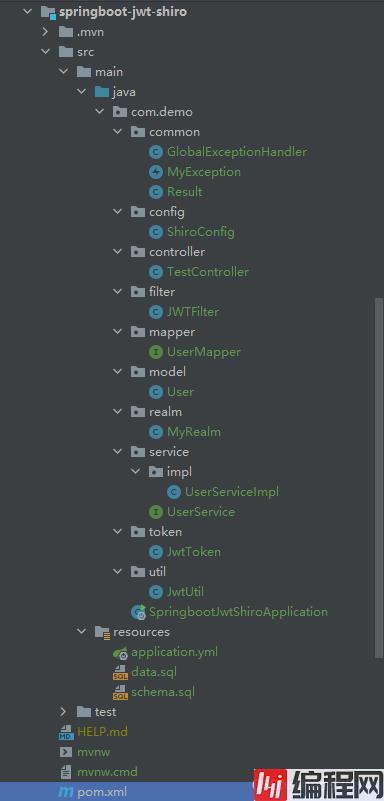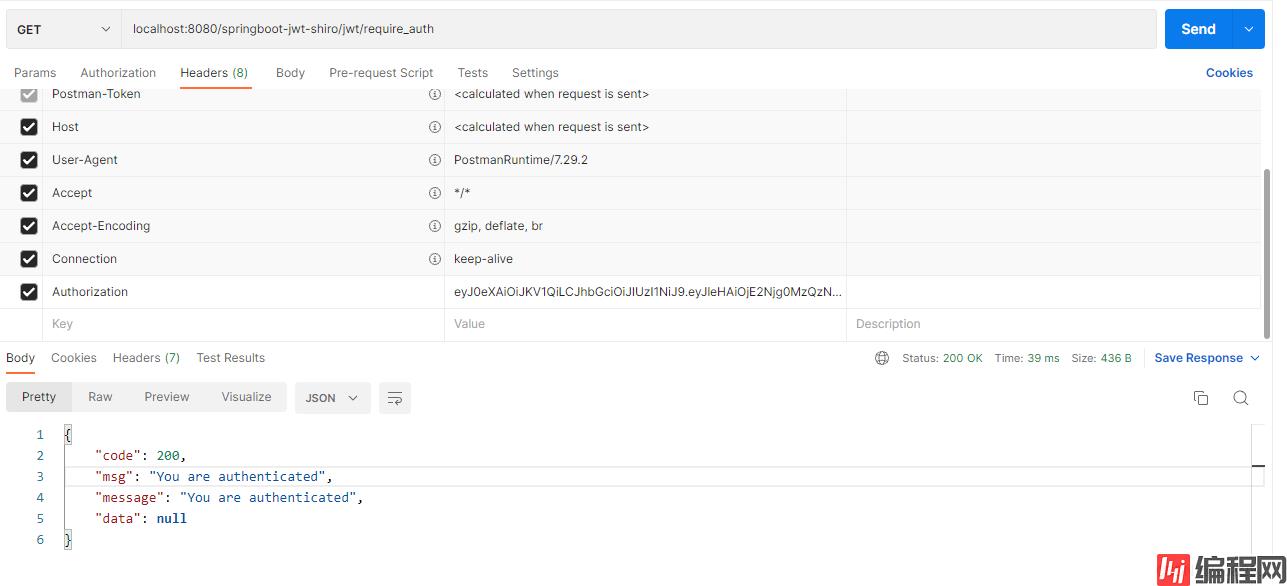Python 官方文档:入门教程 => 点击学习
目录前言实战演练代码结构sql脚本pom依赖UserJwtUtilUserMapperUserServiceUserServiceImplJwtTokenMyRealmJWTFilt
代码库:https://gitee.com/leo825/SpringBoot-learning-parents.git
之前写过《springBoot集成Shiro框架》,最近看了JWT,正好两个整合一下,加深一下理解。

schema.sql
create table if not exists t_user (
`id` int primary key not null ,
`username` char (50) not null,
`passWord` char(50) not null,
`role` char(50) not null,
`permission` char(255) not null
) ;
data.sql
insert into t_user(id, username, password, role, permission) values (0,'smith','smith123','user','view');
insert into t_user(id, username, password, role, permission) values (1,'danny','danny123','admin','view,edit')
数据格式如下:
| username | password | role | permission |
|---|---|---|---|
| smith | smith123 | user | view |
| danny | danny123 | admin | view,edit |
<?xml version="1.0" encoding="UTF-8"?>
<project xmlns="Http://Maven.apache.org/POM/4.0.0" xmlns:xsi="http://www.w3.org/2001/XMLSchema-instance"
xsi:schemaLocation="http://maven.apache.org/POM/4.0.0 https://maven.apache.org/xsd/maven-4.0.0.xsd">
<modelVersion>4.0.0</modelVersion>
<parent>
<groupId>org.example</groupId>
<artifactId>springboot-learning-parents</artifactId>
<version>1.0-SNAPSHOT</version>
</parent>
<groupId>springboot-demo</groupId>
<artifactId>springboot-jwt-shiro</artifactId>
<version>1.0-SNAPSHOT</version>
<name>springboot-jwt-shiro</name>
<url>https://gitee.com/leo825/springboot-learning-parents.git</url>
<description>springboot集成jwt和shiro测试</description>
<properties>
<start-class>com.demo.SpringbootJwtShiroApplication</start-class>
<project.build.sourceEncoding>UTF-8</project.build.sourceEncoding>
<project.reporting.outputEncoding>UTF-8</project.reporting.outputEncoding>
<java.version>1.8</java.version>
<mybatisplus.version>3.5.1</mybatisplus.version>
<freemaker.version>2.3.31</freemaker.version>
<Mysql.version>8.0.28</mysql.version>
</properties>
<dependencies>
<dependency>
<groupId>org.springframework.boot</groupId>
<artifactId>spring-boot-devtools</artifactId>
</dependency>
<dependency>
<groupId>org.springframework.boot</groupId>
<artifactId>spring-boot-starter-WEB</artifactId>
</dependency>
<dependency>
<groupId>org.springframework.boot</groupId>
<artifactId>spring-boot-starter-test</artifactId>
<scope>test</scope>
</dependency>
<dependency>
<groupId>org.projectlombok</groupId>
<artifactId>lombok</artifactId>
</dependency>
<!-- mybatis-plus 所需依赖 -->
<dependency>
<groupId>com.baomidou</groupId>
<artifactId>mybatis-plus-boot-starter</artifactId>
<version>${mybatisplus.version}</version>
</dependency>
<dependency>
<groupId>com.baomidou</groupId>
<artifactId>mybatis-plus-generator</artifactId>
<version>${mybatisplus.version}</version>
</dependency>
<!-- 使用h2内存数据库 -->
<dependency>
<groupId>com.h2database</groupId>
<artifactId>h2</artifactId>
</dependency>
<!-- jwt依赖 -->
<dependency>
<groupId>com.auth0</groupId>
<artifactId>java-jwt</artifactId>
<version>3.8.1</version>
</dependency>
<dependency>
<groupId>com.alibaba</groupId>
<artifactId>fastJSON</artifactId>
<version>1.2.47</version>
</dependency>
<!--引入shrio 选择stater方式-->
<dependency>
<groupId>org.apache.shiro</groupId>
<artifactId>shiro-spring-boot-starter</artifactId>
<version>1.9.0</version>
</dependency>
</dependencies>
<build>
<plugins>
<plugin>
<groupId>org.springframework.boot</groupId>
<artifactId>spring-boot-maven-plugin</artifactId>
</plugin>
</plugins>
</build>
</project>package com.demo.model;
import com.baomidou.mybatisplus.annotation.IdType;
import com.baomidou.mybatisplus.annotation.TableId;
import com.baomidou.mybatisplus.annotation.TableName;
import lombok.Data;
import java.io.Serializable;
@TableName("t_user")
@Data
public class User implements Serializable {
private static final long serialVersionUID = 1L;
@TableId(value = "id", type = IdType.AUTO)
private Integer id;
private String username;
private String password;
private String role;
private String permission;
}package com.demo.util;
import com.auth0.jwt.JWT;
import com.auth0.jwt.JWTVerifier;
import com.auth0.jwt.alGorithms.Algorithm;
import com.auth0.jwt.exceptions.JWTDecodeException;
import com.auth0.jwt.interfaces.DecodedJWT;
import java.util.Date;
public class JwtUtil {
private static final long EXPIRE_TIME = 5 * 60 * 1000;
public static final String SECRET = "jwt_secret";
public static boolean verify(String token, String username, String secret) {
try {
Algorithm algorithm = Algorithm.HMac256(secret);
JWTVerifier verifier = JWT.require(algorithm)
.withClaim("username", username)
.build();
DecodedJWT jwt = verifier.verify(token);
return true;
} catch (Exception exception) {
return false;
}
}
public static String getUsername(String token) {
try {
DecodedJWT jwt = JWT.decode(token);
return jwt.getClaim("username").asString();
} catch (JWTDecodeException e) {
return null;
}
}
public static String sign(String username, String pwd) {
try {
Date date = new Date(System.currentTimeMillis() + EXPIRE_TIME);
Algorithm algorithm = Algorithm.HMAC256(pwd);
// 附带username信息
return JWT.create()
.withClaim("username", username)
.withExpiresAt(date)
.sign(algorithm);
} catch (Exception e) {
return null;
}
}
}
package com.demo.mapper;
import com.baomidou.mybatisplus.core.mapper.BaseMapper;
import com.demo.model.User;
public interface UserMapper extends BaseMapper<User> {
}public interface UserService extends IService<User> {
User getUser(String username) throws AuthenticationException;
}
package com.demo.service.impl;
import com.baomidou.mybatisplus.extension.service.impl.ServiceImpl;
import com.demo.mapper.UserMapper;
import com.demo.model.User;
import com.demo.service.UserService;
import org.springframework.stereotype.Service;
import javax.security.sasl.AuthenticationException;
import java.util.HashMap;
import java.util.List;
import java.util.Map;
@Service
public class UserServiceImpl extends ServiceImpl<UserMapper, User> implements UserService {
@Override
public User getUser(String username) throws AuthenticationException {
Map<String,Object> columnMap = new HashMap<>();
columnMap.put("username", username);
List<User> users = baseMapper.selectByMap(columnMap);
if(users.isEmpty()){
throw new AuthenticationException("User didn't existed!");
}
return users.get(0);
}
}package com.demo.token;
import org.apache.shiro.authc.AuthenticationToken;
public class JwtToken implements AuthenticationToken {
// 密钥
private String token;
public JwtToken(String token) {
this.token = token;
}
@Override
public Object getPrincipal() {
return token;
}
@Override
public Object getCredentials() {
return token;
}
}package com.demo.realm;
import com.demo.model.User;
import com.demo.service.UserService;
import com.demo.token.JwtToken;
import com.demo.util.JwtUtil;
import lombok.SneakyThrows;
import lombok.extern.slf4j.Slf4j;
import org.apache.shiro.authc.AuthenticationException;
import org.apache.shiro.authc.AuthenticationInfo;
import org.apache.shiro.authc.AuthenticationToken;
import org.apache.shiro.authc.SimpleAuthenticationInfo;
import org.apache.shiro.authz.AuthorizationInfo;
import org.apache.shiro.authz.SimpleAuthorizationInfo;
import org.apache.shiro.realm.AuthorizingRealm;
import org.apache.shiro.subject.PrincipalCollection;
import org.springframework.beans.factory.annotation.Autowired;
import org.springframework.stereotype.Component;
import java.util.Arrays;
import java.util.HashSet;
import java.util.Set;
@Component
@Slf4j
public class MyRealm extends AuthorizingRealm {
@Autowired
private UserService userService;
@Override
public boolean supports(AuthenticationToken token) {
return token instanceof JwtToken;
}
@SneakyThrows
@Override
protected AuthorizationInfo doGetAuthorizationInfo(PrincipalCollection principals) {
String username = JwtUtil.getUsername(principals.toString());
User user = userService.getUser(username);
SimpleAuthorizationInfo simpleAuthorizationInfo = new SimpleAuthorizationInfo();
simpleAuthorizationInfo.addRole(user.getRole());
Set<String> permission = new HashSet<>(Arrays.asList(user.getPermission().split(",")));
simpleAuthorizationInfo.addStringPermissions(permission);
return simpleAuthorizationInfo;
}
@SneakyThrows
@Override
protected AuthenticationInfo doGetAuthenticationInfo(AuthenticationToken auth) {
String token = (String) auth.getCredentials();
// 解密获得username,用于和数据库进行对比
String username = JwtUtil.getUsername(token);
if (username == null) {
throw new AuthenticationException("token invalid");
}
User user = userService.getUser(username);
if (!JwtUtil.verify(token, username, user.getPassword())) {
throw new AuthenticationException("Username or password error");
}
return new SimpleAuthenticationInfo(token, token, JwtUtil.SECRET);
}
}package com.demo.filter;
import com.demo.token.JwtToken;
import lombok.extern.slf4j.Slf4j;
import org.apache.shiro.web.filter.authc.BasicHttpAuthenticationFilter;
import org.springframework.http.HttpStatus;
import org.springframework.web.bind.annotation.RequestMethod;
import javax.servlet.ServletRequest;
import javax.servlet.ServletResponse;
import javax.servlet.http.HttpServletRequest;
import javax.servlet.http.HttpServletResponse;
import java.io.IOException;
@Slf4j
public class JWTFilter extends BasicHttpAuthenticationFilter {
@Override
protected boolean isLoginAttempt(ServletRequest request, ServletResponse response) {
HttpServletRequest req = (HttpServletRequest) request;
String authorization = req.getHeader("Authorization");
return authorization != null;
}
@Override
protected boolean executeLogin(ServletRequest request, ServletResponse response) throws Exception {
HttpServletRequest httpServletRequest = (HttpServletRequest) request;
String authorization = httpServletRequest.getHeader("Authorization");
JwtToken token = new JwtToken(authorization);
// 提交给realm进行登入,如果错误他会抛出异常并被捕获
getSubject(request, response).login(token);
// 如果没有抛出异常则代表登入成功,返回true
return true;
}
@Override
protected boolean isAccessAllowed(ServletRequest request, ServletResponse response, Object mappedValue) {
if (isLoginAttempt(request, response)) {
try {
executeLogin(request, response);
} catch (Exception e) {
response401(request, response);
}
}
return true;
}
@Override
protected boolean preHandle(ServletRequest request, ServletResponse response) throws Exception {
HttpServletRequest httpServletRequest = (HttpServletRequest) request;
HttpServletResponse httpServletResponse = (HttpServletResponse) response;
httpServletResponse.setHeader("Access-control-Allow-Origin", httpServletRequest.getHeader("Origin"));
httpServletResponse.setHeader("Access-Control-Allow-Methods", "GET,POST,OPTIONS,PUT,DELETE");
httpServletResponse.setHeader("Access-Control-Allow-Headers", httpServletRequest.getHeader("Access-Control-Request-Headers"));
// 跨域时会首先发送一个option请求,这里我们给option请求直接返回正常状态
if (httpServletRequest.getMethod().equals(RequestMethod.OPTIONS.name())) {
httpServletResponse.setStatus(HttpStatus.OK.value());
return false;
}
return super.preHandle(request, response);
}
private void response401(ServletRequest req, ServletResponse resp) {
try {
HttpServletResponse httpServletResponse = (HttpServletResponse) resp;
httpServletResponse.sendRedirect("/401");
} catch (IOException e) {
log.error(e.getMessage());
}
}
}
package com.demo.config;
import com.demo.filter.JWTFilter;
import com.demo.realm.MyRealm;
import org.apache.shiro.mgt.DefaultSessionStorageEvaluator;
import org.apache.shiro.mgt.DefaultSubjectDAO;
import org.apache.shiro.spring.LifecycleBeanPostProcessor;
import org.apache.shiro.spring.security.interceptor.AuthorizationAttributeSourceAdvisor;
import org.apache.shiro.spring.web.ShiroFilterFactoryBean;
import org.apache.shiro.web.mgt.DefaultWebSecurityManager;
import org.springframework.aop.framework.autoproxy.DefaultAdvisorAutoProxyCreator;
import org.springframework.context.annotation.Bean;
import org.springframework.context.annotation.Configuration;
import org.springframework.context.annotation.DependsOn;
import javax.servlet.Filter;
import java.util.HashMap;
import java.util.Map;
@Configuration
public class ShiroConfig {
@Bean("securityManager")
public DefaultWebSecurityManager getManager(MyRealm realm) {
DefaultWebSecurityManager manager = new DefaultWebSecurityManager();
// 使用自己的realm
manager.setRealm(realm);
DefaultSubjectDAO subjectDAO = new DefaultSubjectDAO();
DefaultSessionStorageEvaluator defaultSessionStorageEvaluator = new DefaultSessionStorageEvaluator();
defaultSessionStorageEvaluator.setSessionStorageEnabled(false);
subjectDAO.setSessionStorageEvaluator(defaultSessionStorageEvaluator);
manager.setSubjectDAO(subjectDAO);
return manager;
}
@Bean("shiroFilterFactoryBean")
public ShiroFilterFactoryBean factory(DefaultWebSecurityManager securityManager) {
ShiroFilterFactoryBean factoryBean = new ShiroFilterFactoryBean();
// 添加自己的过滤器并且取名为jwt
Map<String, Filter> filterMap = new HashMap<>();
filterMap.put("jwt", new JWTFilter());
factoryBean.setFilters(filterMap);
factoryBean.setSecurityManager(securityManager);
factoryBean.setUnauthorizedUrl("/401");
Map<String, String> filterRuleMap = new HashMap<>();
// 所有请求通过我们自己的JWT Filter
filterRuleMap.put("
@Bean
@DependsOn("lifecycleBeanPostProcessor")
public DefaultAdvisorAutoProxyCreator defaultAdvisorAutoProxyCreator() {
DefaultAdvisorAutoProxyCreator defaultAdvisorAutoProxyCreator = new DefaultAdvisorAutoProxyCreator();
// 强制使用cglib,防止重复代理和可能引起代理出错的问题
// https://zhuanlan.zhihu.com/p/29161098
defaultAdvisorAutoProxyCreator.setProxyTargetClass(true);
return defaultAdvisorAutoProxyCreator;
}
@Bean
public LifecycleBeanPostProcessor lifecycleBeanPostProcessor() {
return new LifecycleBeanPostProcessor();
}
@Bean
public AuthorizationAttributeSourceAdvisor authorizationAttributeSourceAdvisor(DefaultWebSecurityManager securityManager) {
AuthorizationAttributeSourceAdvisor advisor = new AuthorizationAttributeSourceAdvisor();
advisor.setSecurityManager(securityManager);
return advisor;
}
}| URL | 作用 |
|---|---|
| /login | 登入 |
| /article | 所有人都可以访问,但是用户与游客看到的内容不同 |
| /require_auth | 登入的用户才可以进行访问 |
| /require_role | admin的角色用户才可以登入 |
| /require_permission | 拥有view和edit权限的用户才可以访问 |
测试代码如下:
package com.demo.controller;
import com.demo.common.Result;
import com.demo.model.User;
import com.demo.service.UserService;
import com.demo.util.JwtUtil;
import lombok.extern.slf4j.Slf4j;
import org.apache.shiro.SecurityUtils;
import org.apache.shiro.authz.UnauthorizedException;
import org.apache.shiro.authz.annotation.Logical;
import org.apache.shiro.authz.annotation.RequiresAuthentication;
import org.apache.shiro.authz.annotation.RequiresPermissions;
import org.apache.shiro.authz.annotation.RequiresRoles;
import org.apache.shiro.subject.Subject;
import org.springframework.beans.factory.annotation.Autowired;
import org.springframework.http.HttpStatus;
import org.springframework.web.bind.annotation.*;
import javax.security.sasl.AuthenticationException;
@Slf4j
@RestController
@RequestMapping("/jwt")
public class TestController {
@Autowired
private UserService userService;
@PostMapping("/login")
public Result login(@RequestParam("username") String username, @RequestParam("password") String password) throws AuthenticationException {
User user = userService.getUser(username);
if (user.getPassword().equals(password)) {
return new Result(200, "Login success", JwtUtil.sign(username, password));
} else {
throw new UnauthorizedException();
}
}
@GetMapping("/article")
public Result article() {
Subject subject = SecurityUtils.getSubject();
if (subject.isAuthenticated()) {
return new Result(200, "You are already logged in", null);
} else {
return new Result(200, "You are guest", null);
}
}
@GetMapping("/require_auth")
@RequiresAuthentication
public Result requireAuth() {
return new Result(200, "You are authenticated", null);
}
@GetMapping("/require_role")
@RequiresRoles("admin")
public Result requireRole() {
return new Result(200, "You are visiting require_role", null);
}
@GetMapping("/require_permission")
@RequiresPermissions(logical = Logical.AND, value = {"view", "edit"})
public Result requirePermission() {
return new Result(200, "You are visiting permission require edit,view", null);
}
@RequestMapping(path = "/401")
@ResponseStatus(HttpStatus.UNAUTHORIZED)
public Result unauthorized() {
return new Result(401, "Unauthorized", null);
}
}
登录成功

到此这篇关于SpringBoot集成整合JWT与Shiro流程详解的文章就介绍到这了,更多相关SpringBoot JWT与Shiro内容请搜索编程网以前的文章或继续浏览下面的相关文章希望大家以后多多支持编程网!
--结束END--
本文标题: SpringBoot集成整合JWT与Shiro流程详解
本文链接: https://www.lsjlt.com/news/174376.html(转载时请注明来源链接)
有问题或投稿请发送至: 邮箱/279061341@qq.com QQ/279061341
下载Word文档到电脑,方便收藏和打印~
2024-03-01
2024-03-01
2024-03-01
2024-02-29
2024-02-29
2024-02-29
2024-02-29
2024-02-29
2024-02-29
2024-02-29
回答
回答
回答
回答
回答
回答
回答
回答
回答
回答
0